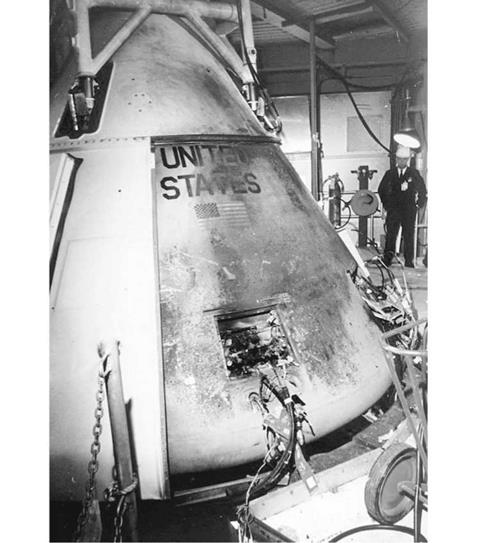NO WAY OUT
Emergency escape procedures said that the hatches could be opened and the cabin evacuated in an orderly fashion in ninety seconds, but in simulations the crew had never achieved anything close to this time. In the evacuation exercises Grissom’s role was to lower White’s headrest so that White could reach above and behind his left shoulder to actuate the ratchet device that would simultaneously loosen the six dogleg latches. The hatch itself was monstrously heavy, and opened inward. As shown on television monitors, White could be seen inserting the ratchet tool into a slot in the hatch. He suddenly snatched his hands back and then reached out once again as Grissom’s hands also came into view, in a desperate attempt to help White with the hatch. Meanwhile the flames, which were mostly on Grissom’s side of the cabin, rapidly grew in intensity, releasing poisonous gases that quickly suffocated the three astronauts.
Some recent research, combined with the independent findings of some NASA engineers, indicates that Grissom also tried to purge the pressure by thrusting his gloved hand through the flames in an attempt to activate the cabin dump valves on a shelf over the left-hand equipment bay. He pressed so hard and so violently that the valves were later found bent. However the valves did not fully engage. In any case, it is doubtful they would have had much effect on the rapidly mounting internal cabin pressure. Meanwhile, the temperature inside the spacecraft had grown high enough to melt stainless steel fittings. Molten balls of nylon were dripping onto everything. White’s safety harness was on fire.
According to one source, White made part of a full turn of the ratchet before he was overcome by the deadly fumes, although it seems probable that the heat would have caused the metal in the hatch to expand and jam. It is widely acknowledged that White put in a mighty but futile effort to open the inner hatch. The last transmission from the spacecraft was a sharp, unidentified cry of pain.
In the meantime, the pressure inside the cabin had escalated to 36 psi, causing a sudden, violent rupture in the spacecraft’s hull from a position adjacent to Chaffee’s helmet across to below his feet. This explosion sealed the crew’s fate. Accompanied by a howling roar, fierce flames and debris spewed out of the breach into the White Room, and fire briefly enveloped the outside of the command module. As the pure oxygen environment in the cabin rapidly depleted, the clear flames deepened in color and lost much of their intensity, replaced by a thick, dark, choking smoke.
From start to tragic finish the fire inside Spacecraft 012 only lasted about 14-17 seconds. Once the violent hull rupture had purged the cabin of oxygen, the fire was essentially extinguished.
Five minutes after the alarm had been raised the booster cover cap was opened, followed soon thereafter by the inner and outer hatches. At first, no one could see through the thick, swirling smoke, and there were no signs of activity from the crew.
Almost another five minutes would pass before the smoke had cleared sufficiently to reveal the inert bodies of the crew. Chaffee, badly injured in the explosion, was still strapped in his seat, while White had collapsed across his seat after several frantic efforts to open the hatch had failed. Even White, said to be among the fittest of the astronauts and as strong as an ox, never really had any chance of opening the hatch in time.
|
The grim aftermath of the fire showing the smoke-blackened hull of Spacecraft 012 after the protective booster cover cap had been removed. (Photo: NASA) |
Grissom was found lying on his back on the floor of the spacecraft, where he had apparently crawled in an attempt to escape the fire. All three had their visors closed. The bodies of Grissom and White were so intertwined below the multilayered hatch that it was difficult to tell them apart. Doctors Fred Kelly and Alan Harter conducted a brief examination of the occupants and pronounced what everyone had known they would find – all three men were dead.
The only thing that could have saved the lives of the three astronauts would have been a fast-opening hatch.











